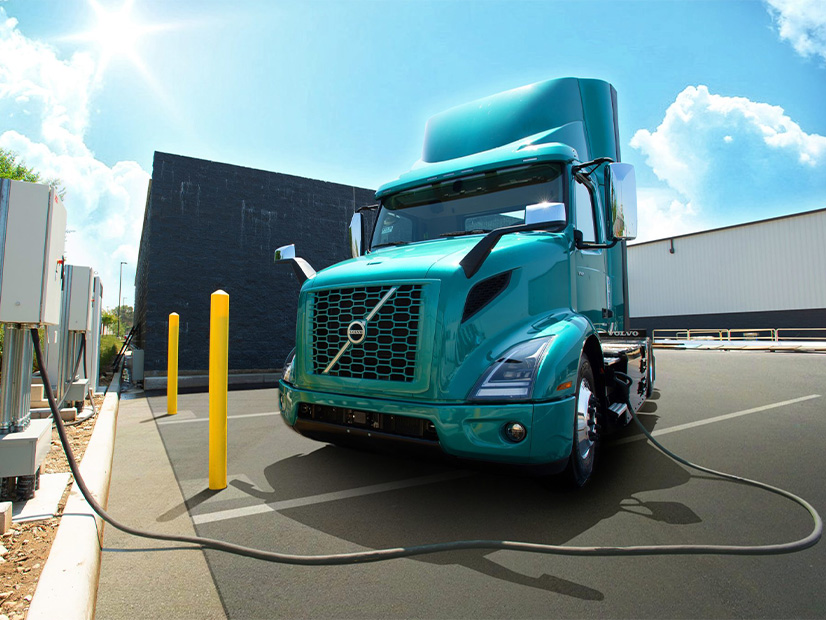
California, Oregon and Washington have jointly applied for federal grant money to build a public charging network for electric trucks across the three states.
The proposed West Coast Truck Charging and Fueling Corridor Project would include 34 truck charging stations and five hydrogen fueling stations. The stations would be primarily along Interstate 5, with some locations on “key connecting corridors,” such as I-710 in the Los Angeles area.
Departments of transportation from California, Oregon and Washington, together with the California Energy Commission (CEC), applied for charging network funding last month from the U.S. DOT’s Charging and Fueling Infrastructure competitive grant program.
The plan was discussed during a joint CEC and California Department of Transportation (Caltrans) workshop. Caltrans declined to reveal the amount of grant funding requested, saying the proposal is under confidential review by the Federal Highway Administration.
The workshop also provided an update on California’s deployment plan for the National Electric Vehicle Infrastructure (NEVI) formula program.
‘Wild West’ of Connector Types
The goal of the $5 billion NEVI program is to establish a nationwide network of public EV chargers along designated alternative fuel corridors. California’s expected share of the funds is $384 million over five years.
One question that kept cropping up during the workshop was how California plans to handle the move toward North American Charging Standard (NACS) charging connectors.
Automakers including Ford, General Motors, Rivian and Volvo announced recently that they would adopt Tesla’s NACS connector as Tesla begins opening its Supercharger network to non-Tesla vehicles.
But federal NEVI guidance requires charging stations to be equipped with the rival combined charging system (CCS) connectors. Each station must have at least four CCS connectors that combined allow four vehicles to charge simultaneously.
That still leaves room for NACS connectors at ports that have more than one connector, according to Energy Commission Specialist Brian Fauble.
“As long as one of those connectors [is] CCS, the other connector can be any other connector, be it NACS, or CHAdeMO, or anything else,” Fauble said. “These other connectors can still be done, as long as you’re still meeting the port requirement of one CCS per port.”
Kentucky has added a requirement that charging stations funded through NEVI include NACS connectors in addition to CCS plugs, Reuters reported last week. Texas and Washington state might do the same.
California isn’t ready to follow suit, officials said during the workshop.
“It’s a little bit of a Wild West scenario right now with things changing so rapidly,” said Jim McKinney in CEC’s Fuels and Transportation Division. “We’re monitoring this and trying to decide how to proceed.”
McKinney said the NACS situation will not impact CEC’s initial NEVI solicitation, which is expected to go out during the third quarter of this year.
California divided its roughly 6,600 miles of alternative fuel corridors into segments that were then gathered into “corridor groups” and ranked by priority. (See Calif. Lays Groundwork for NEVI Solicitations.)
The state’s first NEVI solicitation will cover six corridor groups with 28 new stations and 291 ports.
Complementary Programs
The West Coast Truck Charging and Fueling Corridor Project would be “very complementary” to NEVI, Jimmy O’Dea, Caltrans’ assistant deputy director for transportation electrification, said during the workshop.
O’Dea said there are now only four publicly accessible truck charging stations across the West Coast.
“This would be a significant addition to the industry that we know is growing so rapidly,” he said.
Charging stations included in the project would each have at least five 350-kW dual-port chargers. Stations along I-710 would each have 10 chargers to serve drayage trucks working at the California seaports.
The stations would also support a megawatt charging system upgrade.
Each of the five hydrogen fueling stations would host two dispensers and have a 10,000-kg-per-day capacity.
Some commenters urged CEC to use a portion of NEVI funding for medium- and heavy-duty truck charging.
Sean Waters, vice president of compliance and regulatory affairs for Daimler Truck North America, said some of the NEVI-funded stations should be configured with a pull-through charging lane that could accommodate cars or large trucks.
While recharging at depots is common for trucks today, more fleets could be looking for public charging in the future due to high costs and infrastructure constraints of “behind-the-fence” charging equipment, Waters said in written comments to the CEC.
“Light-duty vehicles can utilize sites designed for medium- and heavy-duty vehicles, but the opposite is not possible,” Waters noted.